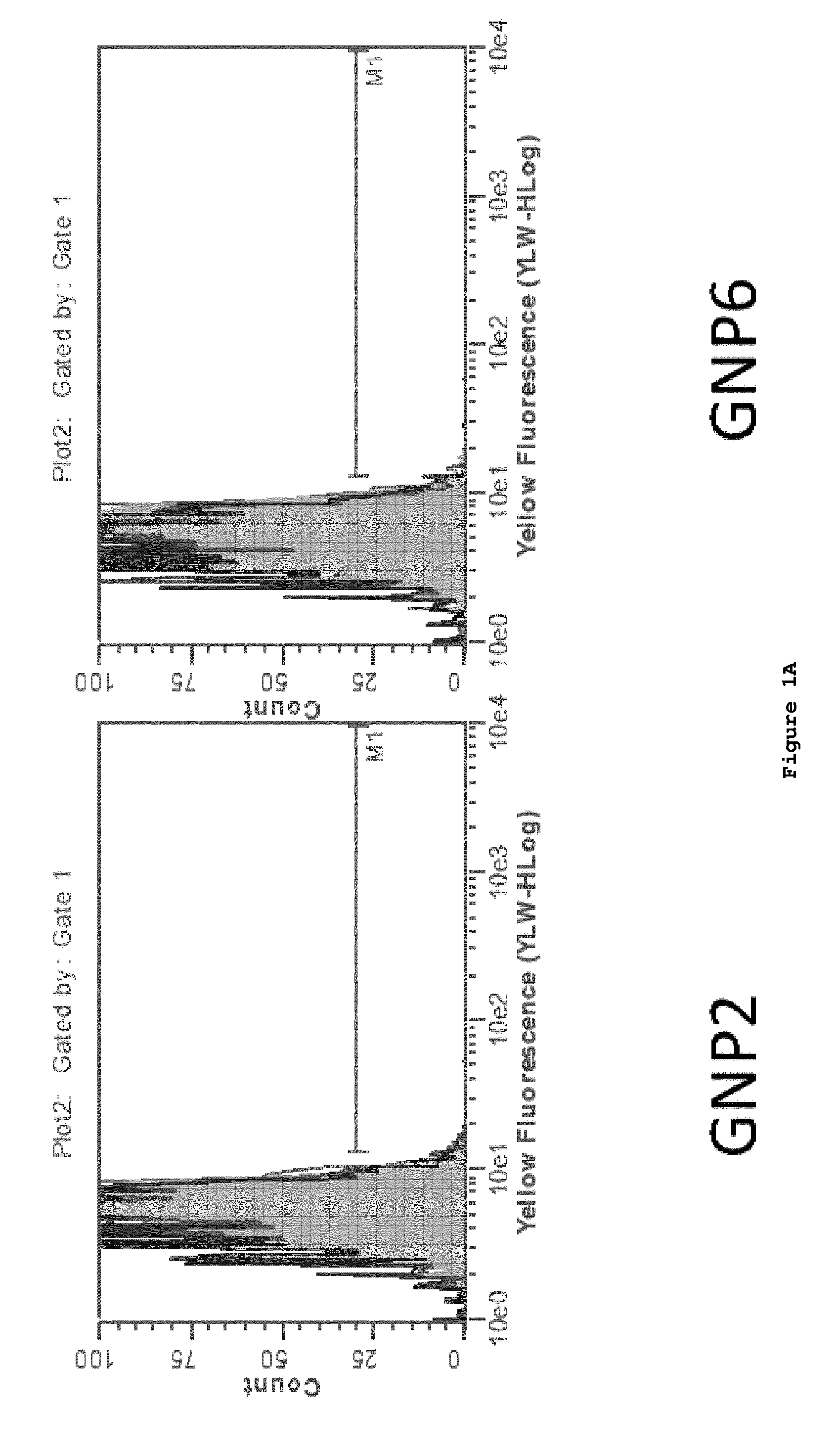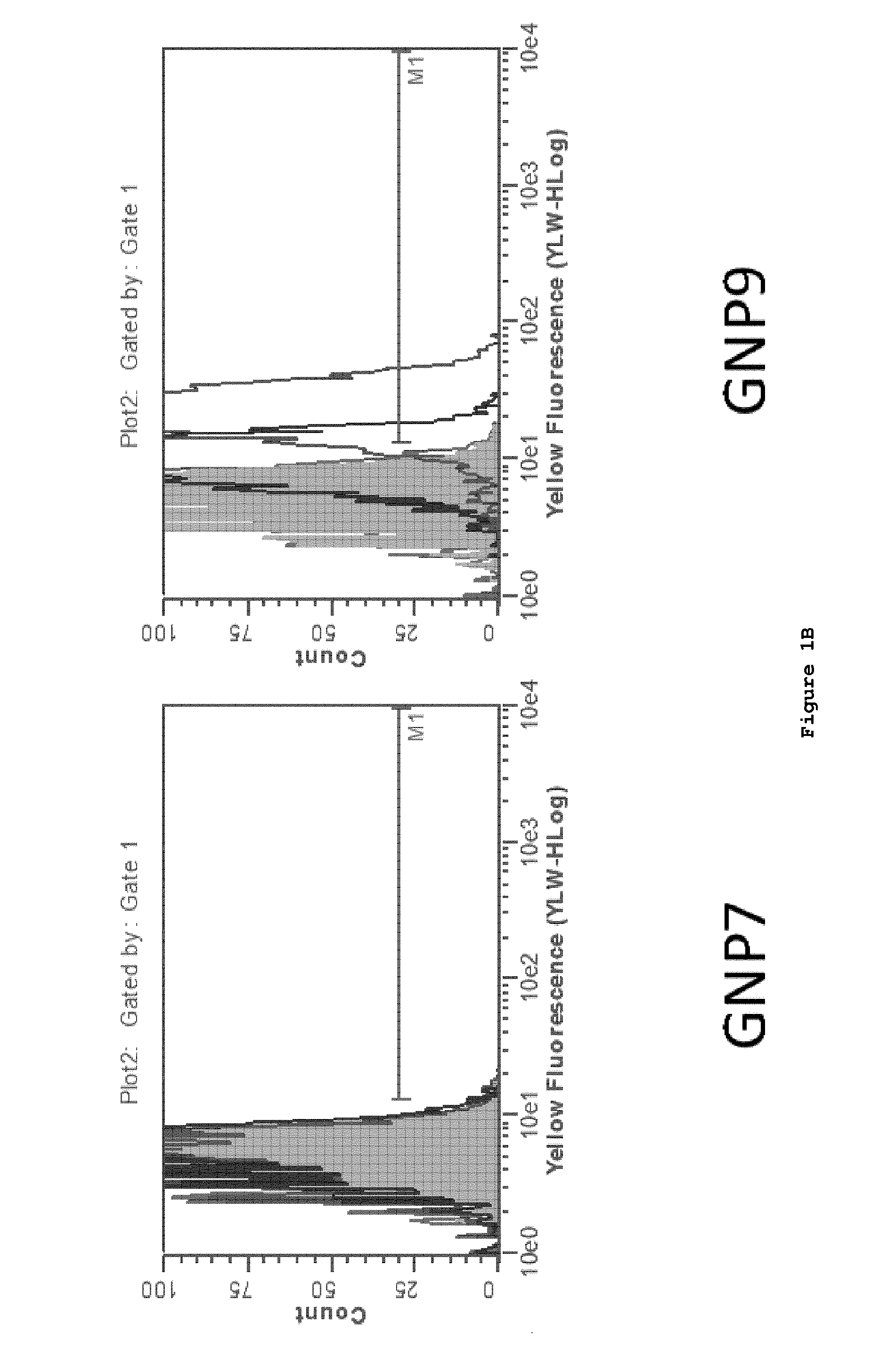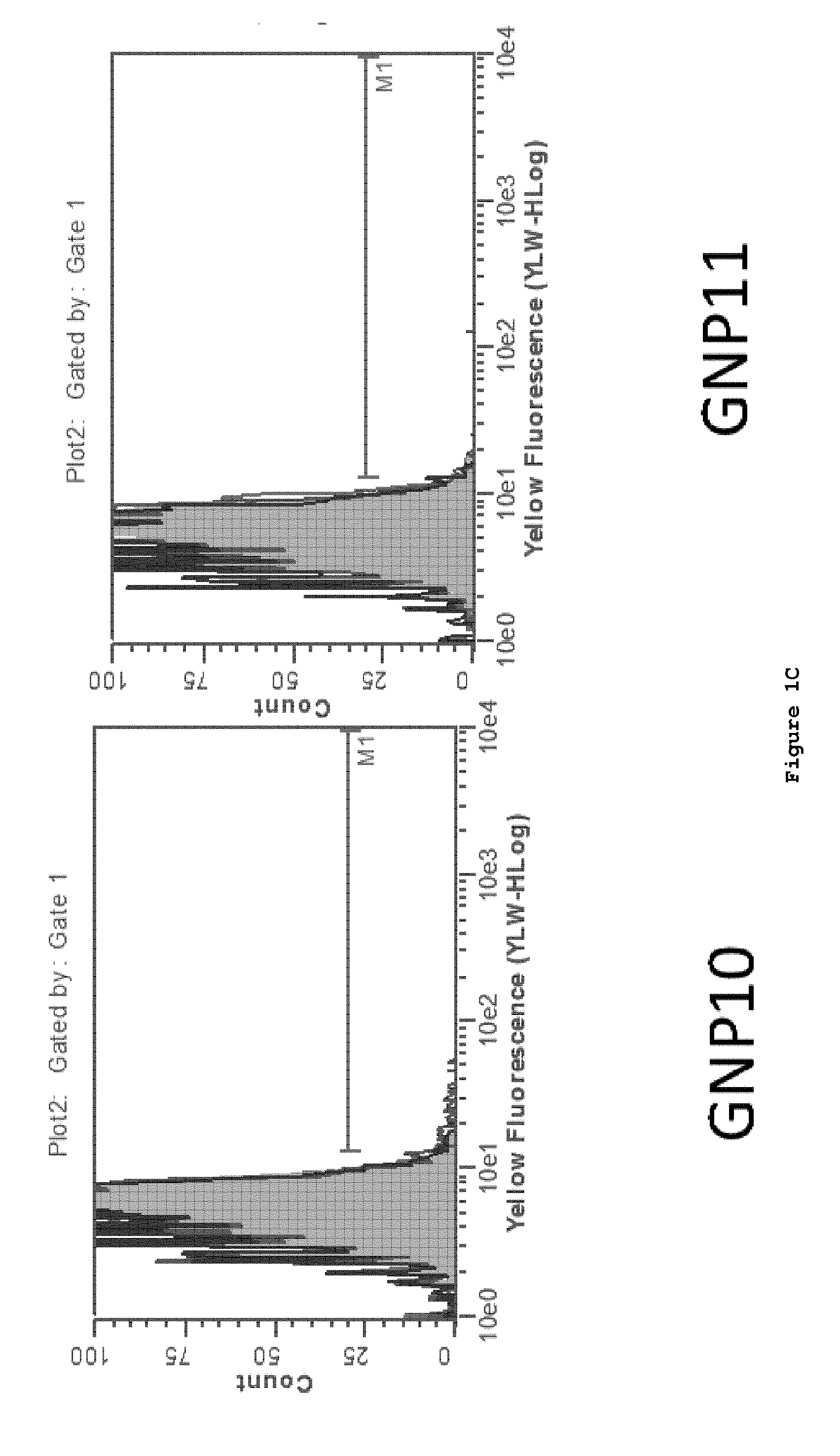Nanoparticle tumour vaccines
a technology of nanoparticles and tumour vaccines, applied in lung cancer vaccines, immunological disorders, lung cancer vaccines, etc., can solve the problems of insufficient expression of the class i mhc molecule itself and the number of adjuvants considered too toxi
- Summary
- Abstract
- Description
- Claims
- Application Information
AI Technical Summary
Benefits of technology
Problems solved by technology
Method used
Image
Examples
example 1
Synthesis and Characterisation of Nanoparticles
[0117]Test ligands and their identification numbers are given below (Molecular wt);
(SEQ ID NO: 87)SIINFEKL (963)SIINFEKL-N-(CH2)2-SH (1021)(SEQ ID NO: 88)FLSIINFEKL-N-(CH2)2-SH (1280)(SEQ ID NO: 89)FLAAYSIINFEKL-N-(CH2)2-SH (1587)(SEQ ID NO: 90)AAYSIINFEKL-N-(CH2)2-SH (1325)HS(CH2)2-CONH-SIINFEKL (1051)HS(CH2)2-CONH-FLSIINFEKL (1309)HS(CH2)2-CONH-FLAAYSIINFEKL (1616)HS(CH2)2-CONH-AAYSIINFEKL (1356)HS-(CH2)10-(CH2OCH2)7-CONH-SIINFEKL (1471)HS-(CH2)10-(CH2OCH2)7-CONH-FLSIINFEKL (1732)HS-(CH2)10-(CH2OCH2)7-CONH-FLAAYSIINFEKL (2034)HS-(CH2)10-(CH2OCH2)7-CONH-AAYSIINFEKL (1774)
[0118]Test NPs were synthesized using 10 μmole Gold Chloride (Aldrich 484385), 30 μmole glucose with a thio ethyl linker (GlcC2) and 1.5 μmole of peptide ligand (variable 1.5-3 mg).
[0119]The following method was used; 1.5 μmole peptide was dissolved in 2 ml methanol, followed by the addition of 30 μmole GlcC2 in 200 μl methanol, and 116 μl of aqueous gold chloride cont...
example 2
Evaluation of Presentation Assays
[0142]T cell receptors (TCR) are on the surface of T lymphocytes and recognize peptides in the context of major histocompatibility complex (MHC) (1). Generally, antigen presenting cells (APC) contain machinery to process proteins and load them onto empty MHC. While CD4+ T cells recognize MHC Class II (MHCII), CD8+ T cells respond to MHC Class I (MHCI). Conventionally, MHCII peptides derive from endocytosed components of the extracellular milieu. In contrast, MHCI loads peptides processed from an intracellular source (1, 2).
[0143]SIINFEKL (SEQ ID NO: 87), a peptide epitope that is derived from ovalbumin (OVA), is presented in the context of a murine MHCI allele termed H-2Kb (3). If OVA is expressed in a murine cell expressing H-2Kb, SIINFEKL (SEQ ID NO: 87) is presented conventionally. However, if OVA is supplied exogenously, SIINFEKL can be presented by an alternative process known as MHCI cross-presentation (4, 5). In fact, haplotype-matched mouse i...
example 3
Nanoparticle-Peptide Presentation Assays
[0161]The test ligands listed below were constructed and attached to gold nanoparticles (GNP) by the above-described linker chemistry.
(SEQ ID NO: 87)1. SIINFEKL 2. SIINFEKL-N-(CH2)2-SH(SEQ ID NO: 88)3. FLSIINFEKL-N-(CH2)2-SH (SEQ ID NO: 89)4. FLAAYSIINFEKL-N-(CH2)2-SH (SEQ ID NO: 90)5. AAYSIINFEKL-N-(CH2)2-SH 6. HS(CH2)2-CONH-SIINFEKL7. HS(CH2)2-CONH-FLSIINFEKL8. HS(CH2)2-CONH-FLAAYSIINFEKL9. HS(CH2)2-CONH-AAYSIINFEKL10. HS-(CH2)10-(CH2OCH2)7-CONH-SIINFEKL11. HS-(CH2)10-(CH2OCH2)7-CONH-FLSIINFEKL12. HS-(CH2)10-(CH2OCH2)7-CONH-FLAAYSIINFEKL13. HS-(CH2)10-(CH2OCH2)7-CONH-AAYSIINFEKL
[0162]SIINFEKL (SEQ ID NO: 87), an epitope derived from ovalbumin that is presented in the context of the murine MHCI molecule H-2 Kb, was measured using two methods. One method utilized a TCR-like antibody termed 25.D1.16, also referred to as “Angel”, that recognize SIINFEKL / MHCI complex. In addition, we assessed presentation using the B3Z, SIINFEKL (SEQ ID NO: 87) p...
PUM
| Property | Measurement | Unit |
|---|---|---|
| diameter | aaaaa | aaaaa |
| diameter | aaaaa | aaaaa |
| diameter | aaaaa | aaaaa |
Abstract
Description
Claims
Application Information
 Login to View More
Login to View More - R&D
- Intellectual Property
- Life Sciences
- Materials
- Tech Scout
- Unparalleled Data Quality
- Higher Quality Content
- 60% Fewer Hallucinations
Browse by: Latest US Patents, China's latest patents, Technical Efficacy Thesaurus, Application Domain, Technology Topic, Popular Technical Reports.
© 2025 PatSnap. All rights reserved.Legal|Privacy policy|Modern Slavery Act Transparency Statement|Sitemap|About US| Contact US: help@patsnap.com



